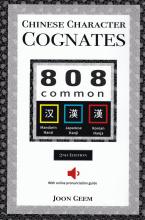Review of Chinese Characters Cognates - 808 Common Hanja

This book by Joon Geem lists the 808 most common 한자 Chinese characters in Mandarin (hanzi), Japanese (kanji), and Korean (한자) in a compelling format. This book is particularly recommended to language learners or both Japanese and Korean or Chinese and Korean. For each of the 808 most common Chinese characters across China, Korean, and Taiwan; the author lists the corresponding simplified Chinese character, the Japanese kanji, and the Korean hanja (한자). The author also provides three vocabulary words using the corresponding Chinese character for each language, allowing comparisons between Chinese and Korean for example.
Stronger points:
- Goes straight to the point; no convoluted explanations that are present in some books.
- Invaluable resource if you are learning two or more East Asian languages at the same time, or if you are trying to learn a new East Asian language and you are already familiar with one.
- Three indexes (Mandarin, Korean, Japanese) of all the characters in the book, ordered by their pronunciation in the corresponding language.
- QR codes pointing to the pronunciation of the characters in their native language are provided for each of the 808 Chinese characters.
- The etymology of characters is also provided, useful for making logical connections between characters.
Weaker points:
- Traditional Chinese characters (Hong Kong, Taiwan) are not provided; while these are often close to the Korean 한자 (hanja), a footnote to indicate when they differ would be appreciated.
- The examples given in the three languages (Mandarin, Korean, Japanese) do not always match each other, but this is understandable given the limited space constraints.
Below is a sample of the page including the character 火 (화).

This book is a good buy for advanced learners of Korean who want to take their skills one step further, or for Korean learners coming from another East Asian language.